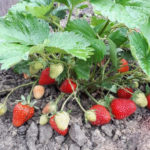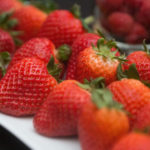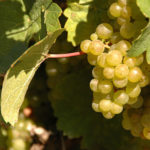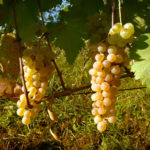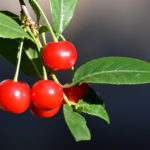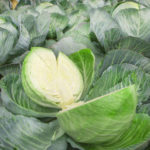Merlot grape variety
Merlot is an excellent and widespread dark colored technical grape native to France. Belongs to the Western European ecological-geographical group. Its small homeland is the famous province of Bordeaux, which has long been famous for its wonderful traditions of viticulture and winemaking. The name comes from one of the Old French dialects, in which "merlot" is a diminutive of the word "merle", which means "blackbird". According to some researchers, the name is due to the fact that these birds loved to feast on grapes, others suggest that the whole thing is in the figurative similarity of a black bird and a bunch of grapes.
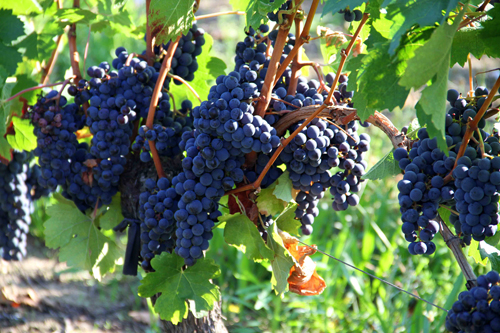
The first mentions of Merlot are in the notes of a local official from Bordeaux, who in 1784 named the wine made from these grapes one of the best in the Libourne region. In the 19th century, this variety begins to spread throughout France, and then throughout the European continent. Already in the XX century, winegrowers of the New World became interested in the variety, where over time, very significant in terms of planting area were concentrated. Currently, around the world, our hero's plantings occupy about 270 thousand hectares, which makes him one of the leaders in prevalence, and according to some sources - the most popular variety of dark-colored grapes on the globe. Besides France, it is distributed in Italy, Algeria, USA, Romania, Australia, Argentina, Bulgaria, Canada, Chile, Greece, New Zealand, South Africa, Switzerland, Croatia, Hungary, Montenegro, Slovenia, Mexico and other countries. At the same time, one cannot fail to mention an interesting fact: after a series of unsuccessful seasons, including severe frosts in 1956 and several crops in the 1960s, lost due to rot, in the homeland of the variety, in Bordeaux, the French authorities banned new plantings of Merlot vines. ... The ban lasted five years - from 1970 to 1975, however, in the end, common sense still prevailed, and the authorities abandoned their idea.
In the 90s of the XX century, researchers from the University of California at Davis, based on DNA analysis, proved that Merlot is a descendant of Cabernet Franc, and can be considered the half-brother of Malbec and Cabernet Sauvignon... The second parent was not discovered until the late 2000s, when genetic analysis pointed to a little-known and unnamed variety as the mother form of the famous Bordeaux grape. For the first time, its DNA samples were taken from plants growing in an abandoned vineyard in Sainte-Suliac in Brittany, but then this variety was discovered in front of houses as an ornamental vine in a number of local villages. Colloquially, she was known as Madeleine or Raisins de la Madeleine because of the early ripening of the bunches, which are ready to be harvested as early as July 22 on the day of Mary Magdalene. When the connection with Merlot became known, the grape was officially registered under the name Magdalen Noire des Charentes (Magdeleine Noire des Charentes).

Breeders actively used our hero for crossing with other varieties, as a result of which a significant number of his quite worthy descendants appeared. In addition, over the years of its existence, it has spawned a color mutation known as Merlot Gris, which has a pink berry coloration and is also widely cultivated. That being said, the light-colored grape known as Merlot Blanc is not a color clone, but rather a variety of Merlot offspring crossed with Voll Blanche.
Agrobiological characteristics
Plants of medium or above medium vigor. The crown of a young shoot is gray, with a noticeable pink spot on the tips of the blossoming leaves, covered with dense tomentose pubescence. Young leaves are green in color with a slight bronze tint.The standard leaf is dark green, medium-sized (15x16cm), rounded, funnel-curved in appearance, five-lobed with an average degree of dissection. The surface of the leaf blade is vesicular-wrinkled, the reverse side has a rare cobweb pubescence. The upper side cuts are relatively deep, usually closed with an elliptical opening, often with a notch at the bottom. The lower notches are medium in depth, open, lyre-shaped, with a narrow aperture or parallel sides. Petiole notches are found in various forms: open arched or lyre-shaped with a pointed bottom, as well as closed ones with an ovoid lumen. The denticles along the edge of the leaf blade are of medium size, triangular with sharp apices and barely curved edges. The flowers of the variety are bisexual, well pollinated with their own pollen, however, peas are quite common, in which the underdeveloped grapes remain green at the time of harvest. The vine ripens perfectly by the time of frost in the fall (90−95%). Ripe shoots of grapes acquire a yellowish-brown color with slightly darker areas in the area of \ u200b \ u200bthe nodes. The autumn color of the foliage is reddish-yellow.
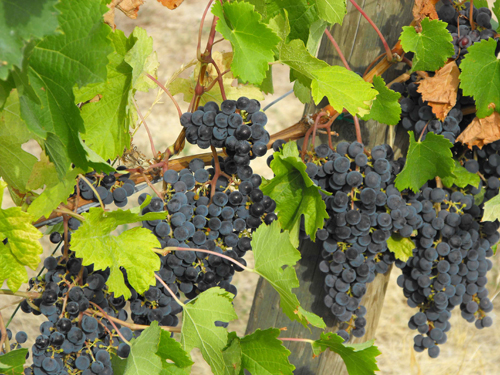
The size of the Merlot bunches is average. Usually they are 12-17 cm long, 7-12 cm wide. The shape is cylindrical-conical or winged, the density is moderate. The mass of a bunch usually ranges from 110-150 grams. The comb is of medium length. The berries are also medium in size, round, 12-14 mm in diameter and weighing 1-1.4 grams, black, covered with a thick protective coating of prune. The pulp of the variety is juicy, has a pleasant harmonious taste with a nightshade or herbaceous shade. Freshly squeezed juice is colorless, the content of glucose and fructose in it depends on the timing of harvesting grapes, ranging from 19.5 to 22 grams / 100 cubic meters. cm, titratable acidity also varies in the range of 5.2-8.5 grams / cubic dm. The skin is somewhat coarse, medium in thickness, strong. The berry contains from one to three seeds. From the total mass of the crop during processing, 73-74% of the juice, 22-23% of the skin, dense parts of the pulp and seeds, as well as 4-5% of the ridges come out.
The grapes are used to make excellent red table and dessert wines with a mild taste and delicate delicate bouquet. Especially high-quality raw materials are provided by old powerful bushes, while young plantings are just preparing to become ideal for great drinks. Although Merlot is produced all over the world, there are two main styles of wine making. The “international style” favored by many wine-growing regions in the New World is characterized by late harvest, in order to achieve physiological maturity and the subsequent production of dark-colored, full-bodied wines with a high alcohol content, soft, velvety tannins and intense notes of plum and blackberry in the aroma. The traditional Bordeaux style involves harvesting earlier to maintain acidity and produce wines with moderate alcohol levels that have a fresh fruity bouquet with strawberry and raspberry tones and herbaceous notes. Merlot's softness and velvety make it a popular blend variety with a harsher and harsher Cabernet Sauvignon, which tends to be higher in tannins.
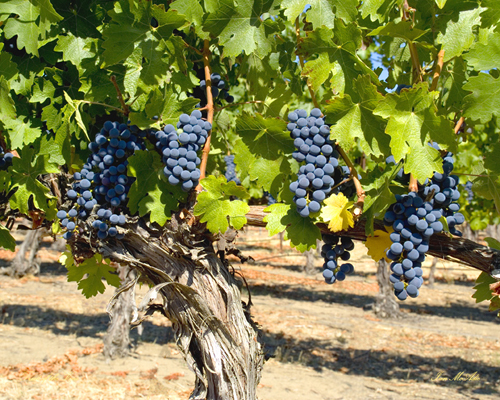
The grapes are late ripening. The growing season from bud break to the onset of removable ripeness is at least 150-155 days for the production of table wines, and 160-165 for dessert. The collection usually takes place from late September to mid-October. The required sum of active temperatures, depending on the timing of harvesting, ranges from 3000 to 3300 ° C. Under domestic conditions, this limits the possibility of its cultivation only in southern, traditionally viticultural regions. At the same time, it is also characterized by not the highest frost resistance, which requires its shelter in areas of cultivation, where the winter temperature drops below −21 ... −22 ° С.
The productivity of the variety is usually slightly higher than that of its brother and at the same time its main competitor - Cabernet Sauvignon.This is due to a larger bunch of Merlot, while the fertility of plants is at an average level for the noble European technical varieties. On fertile soils, it tends to be overloaded, which affects the quality of the crop, and the strength of the growth of the shoots, as well as their ripening. The average yield is 45−55 kg / ha. The proportion of fruitful shoots is 52-53%, the number of clusters per developed shoot is on average 0.6, per fruitful - 1.2. Dormant and replacement buds are usually not fertile. This is especially unpleasant due to the variety's propensity for early flowering, which increases the risk of crop loss due to recurrent frosts.
After ripening, the grapes can continue to hang on the bushes, accumulating sugar and reducing acidity. The result is excellent raw materials for dessert and specific dry wines. In this case, damage by wasps does not occur, however, sweet berries can become easy prey for birds that huddle in the fall in flocks. This requires action to keep birds away from the vineyard.
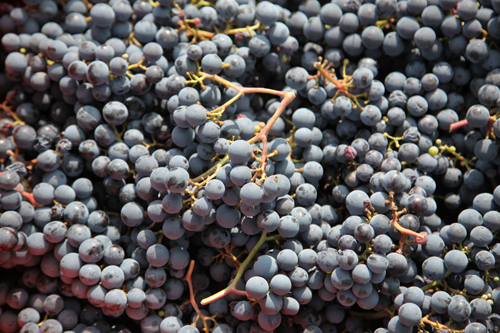
Agrotechnical features
Despite the somewhat better economic qualities of Merlot in comparison with other Western European varieties, its cultivation requires a competent approach and a clear understanding of the necessity and importance of each technological operation.
For placement it prefers warm slopes with ordinary, typical or carbonate chernozems, medium or heavy in texture. Too dry, or vice versa, damp and wetlands, as well as lowlands and northern slopes, are categorically unsuitable. The grapes are unstable to phylloxera, and therefore phylloxera-resistant seedlings are used for planting plantations. The recommended rootstocks are Riparia x Rupestris 101-14, Berlandieri x Riparia CO4, Berlandieri x Riparia Kober 5BB.
The bush management scheme should be determined depending on the local climatic conditions in winter and the ability of the variety to overcome the cold season without damage. Ideally, a high-stamped shaping with a large supply of perennial wood and a free arrangement of annual growth is preferable for Merlot. The planting pattern will be about 3 meters between rows and 1.25-1.5 m between plants in a row. However, this option is applicable only in the case of rather mild winters, and there is no risk of death, in general, not too frost-resistant grape bushes. In the absence of such guarantees, it is necessary to take care of protecting the vines from frost, which will require the use of stampless forms - fan-shaped multi-arm or inclined cordon. Thanks to this, the above-ground part of the bush can be quite easily removed from the trellis and covered with earth, or with available organic materials: straw, sawdust, fallen leaves, reeds
Determining the load on the variety in spring and regulating it during the growing season is the basis for obtaining a significant amount of Merlot harvest. It is worth noting here that a number of French, and not only, winemakers advocate a deliberate decrease in yield in order to improve the quality of wine, however, if we are not talking about exclusive drinks, this approach seems inappropriate. The optimal load can be called a load of 50-60 eyes per bush with an average length of pruning of fruit arrows for 4-6 buds. Additional regulation of the load is carried out in the course of green operations, when excess sterile and weak shoots break off on the plants.As a result, in the fall, an average of about five kilograms of grapes are harvested from the bush.
In relation to fungal diseases, Merlot behaves as follows: it still demonstrates some resistance to mildew and gray rot, but it is very strongly affected by powdery mildew. This requires numerous treatments with fungicides according to schemes of protection of unstable varieties, with only minimal indulgences in relation to rot and downy mildew.
Harvesting must be done in the context of future plans for the production of a particular type of wine. It should be borne in mind that Merlot is characterized by rapid overripening after the onset of technological ripeness. Grapes that have accumulated significant amounts of sugar will no longer make the exclusively wine that is produced in his homeland in Bordeaux. However, it cannot be said that in the case of late harvesting of the bunches, the drink from them will become worse. Many wineries in the world also work in this way, and their product has a huge army of sincere admirers.
